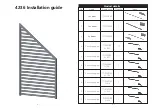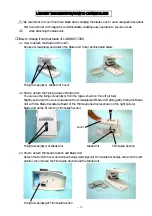
STANDARD RECOMMENDED PROCEDURE 003-873 | ISSUE 2 | APRIl 2016 | PAGE 18 OF 18
Corning Optical Communications LLC • PO Box 489 • Hickory, NC 28603-0489 USA
800-743-2675 • FAX: 828-325-5060 • International: +1-828-901-5000 • www .corning .com/opcomm
Corning Optical Communications reserves the right to improve, enhance, and modify the features and specifications of Corning Optical Communications products
without prior notification. A complete listing of the trademarks of Corning Optical Communications is available at www.corning.com/opcomm/trademarks. All other
trademarks are the properties of their respective owners. Corning Optical Communications is ISO 9001 certified. © 2011, 2016 Corning Optical Communications.
All rights reserved.
12 . Connector Care and Cleaning
•
Always keep dust caps on connectors and adapters when not in use.
• Ensure dust caps are clean before reuse.
•
Use optical cleaning materials as standardized by your company.
•
Clean the connector before every mating, especially for test equipment patch cords
(jumpers).
•
A minimum level of cleaning is listed below. Local procedures may require more rigorous
cleaning methods.
WARNING:
Isopropyl alcohol is flammable with a flashpoint at 54ºF. It can cause irritation to
eyes on contact. In case of contact, flush eyes with water for at least 15 minutes. Inhalation
of vapors irritates the respiratory tract. Exposure to high concentrations has a narcotic effect,
producing symptoms of dizziness, drowsiness, headache, staggering, unconsciousness and
possibly death.
Step 1:
Remove plugs from the connector adapter.
Step 2:
Wipe the connector ferrule twice with a lint-free wiping material moistened with
isopropyl alcohol. Then wipe across the end of the ferrule.
Step 3:
Repeat previous step with a dry wipe.
If necessary to clean the connectors mated to the rear of the connector adapters, rotate the
latch on the distribution field and swing the panel to the open position as shown in Figure 8.
Clean and remate the connectors. Close and latch the panel when complete.
13 . Securing the Cabinet
When all work operations inside the cabinet are complete, secure
the door.
Step 1:
Replace the door, if previously removed, See “Opening
the Cabinet” on page 7.
Step 2:
Close the door and, using a 216B tool, rotate the
tool to the right to lock the door latch (Figure 27). For
additional security, insert a padlock through the holes
in the hasp around the 216B lock.
KPA-0888
Figure 27
— Lock the Door

































